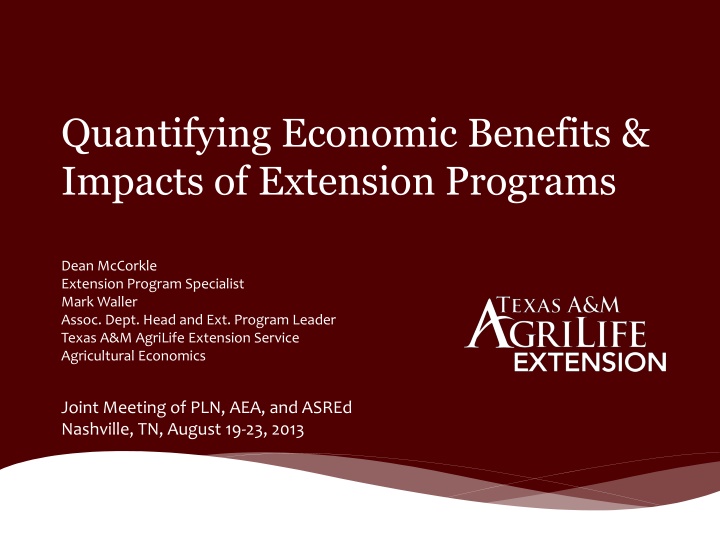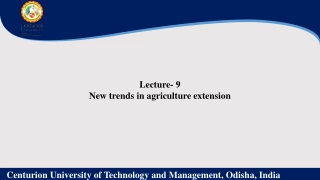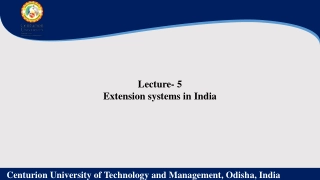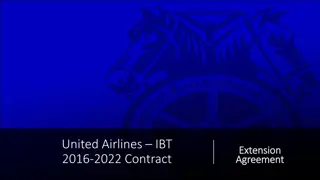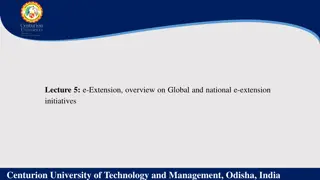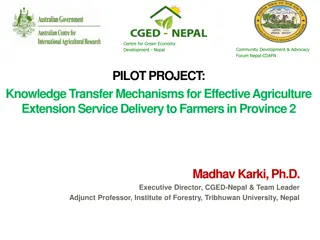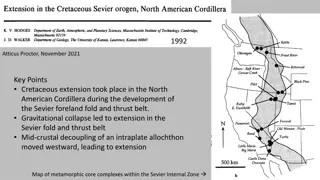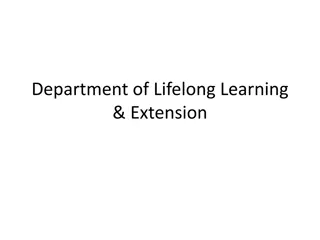Economic Impact Assessment in Extension Programs
This presentation discusses the quantification of economic benefits and impacts of Extension programs, focusing on accountability, program priorities, and evaluating outcomes to demonstrate the value of public funds. It covers the process of development, strategic planning, and reporting at the local and state levels.
Download Presentation

Please find below an Image/Link to download the presentation.
The content on the website is provided AS IS for your information and personal use only. It may not be sold, licensed, or shared on other websites without obtaining consent from the author.If you encounter any issues during the download, it is possible that the publisher has removed the file from their server.
You are allowed to download the files provided on this website for personal or commercial use, subject to the condition that they are used lawfully. All files are the property of their respective owners.
The content on the website is provided AS IS for your information and personal use only. It may not be sold, licensed, or shared on other websites without obtaining consent from the author.
E N D
Presentation Transcript
Quantifying Economic Benefits & Impacts of Extension Programs Dean McCorkle Extension Program Specialist Mark Waller Assoc. Dept. Head and Ext. Program Leader Texas A&M AgriLife Extension Service Agricultural Economics Joint Meeting of PLN, AEA, and ASREd Nashville, TN, August 19-23, 2013
Overview Development, Reporting, Accountability Federal Integrated Report Identifying issues at local-level State Strategic Plan Program Priorities Evaluating Programs ------ Economic Impact Briefs Identifying issues at the local level County level leadership advisory board Issues forum every 4th year Update issues every year Programs priorities (Regional Program Directors)
Overview (Contd) Federal Integrated Report Identifying issues at local-level State Strategic Plan Program Priorities Evaluating Programs ------ Economic Impact Briefs State Strategic Plan (5-yr rolling plan) Imperatives, Goals, and Strategies Sustain food/fiber/green industry Protect/serve natural resources Support CED Improve health, nutrition, safety, and economic security Prepare Texas youth
Overview of Program Federal Integrated Report Identifying issues at local-level State Strategic Plan Program Priorities Evaluating Programs ------ Economic Impact Briefs Evaluating programs Agents and specialists Supported by program evaluation faculty Moving toward 4-5 statewide program evaluations each year Federal Report Report select areas from strategic plan Economic Impact Briefs
Introduction Economic accountability: measuring and interpreting economic benefits and impacts of Extension programs to demonstrate accountability for our use of public funds
Target Audience Elected officials and legislative staff State, Federal, Local/County Texas House and Senate Committees Grantors, TAMUS Chancellor, others Available on Texas A&M AgriLife Extension web site
Process of Developing Economic Impact Briefs Program leaders & specialists suggest programs Ext. Admin. reviews before publishing Follow-up with specialists Texas A&M AgriLife Extension Service Process for Developing Extension Economic Impact Briefs Develop list of target programs 3-member review team Conduct analysis and develop Work with admin. to prioritize
Types of Economic Benefits Tangible Benefits Intangible Benefits Contingent Valuation Willingness To Pay Private (Direct) Benefits Public Benefits
Economic Benefits that most often can accrue from various types of programs Intangible Tangible Private Benefits Public Benefits Program Area Agricultural Environmental & Nat. Res. Community/Econ Development Nutrition Health 4-H & Youth
Agricultural programs: What do we need to measure? Economic indicators Determine most appropriate economic indicator: Improved net farm income (profitability) .due to: Adoption of best management practice (BMP), leading to Cost reduction (variable, fixed) Increased production (and gross income) Improved efficiency Improved alternative crop Technology adoption Debt reduction, improved equity position Jobs Employee compensation (wages/salaries) Property value
Environmental and Natural Resources: Common economic indicators . Determine most appropriate economic indicator: Water quantity (conservation) Amount conserved (valued at a price) Water quality (environmental benefit) Water shed protection planning Removal of watershed from EPA s list of impaired watersheds Feral hog abatement Reduction in feral hog damage
Certification and continuing ed. programs: Economic Indicators . For certification programs: examples from Texas: Pesticide safety applicators On-site wastewater treatment service providers Child care provider education Continuing education programs for county government Landscape irrigators certification Economic benefit not easy to quantify Describe participants in economic terms: No. of jobs Wage and salary base
Certification programs (Contd) Extension certification/licensing programs directly support: No. of jobs supported Salaries/wages supported Child care 2,865 $233 Mill. On-site wastewater treatment 64 $1.9 Mill. Pesticide Safety* 18,624 $729 Mill. County Gov t 1,964 $91 Mill. Landscape irrigation 423 $9 Mill. Total 23,940 $1.06 Bill.
What type of data do I need? It depends on the situation, but in general: For adoption of practice: Program evaluation, self-reported USDA-NASS USDA-AMS (Ag Marketing Survey) (ex: acres planted by cotton variety) USDA-ARMS (Ag Resource Management Survey) SBCEO (Scientific Best Conservative Educated Opinion)
What type of data do I need (Contd)? Livestock and other inventories Census of Agriculture (USDA) USDA-APHIS (ex: Dairy management practices) Commodity Prices USDA/AMS/NASS-State offices Livestock Marketing Information Center (LMIC) Fuel/energy prices U.S. Energy Information Agency EnergyWise (electricity)
Data (Contd) Extension Crop & Livestock Budgets Great resource to make use of Relevant research findings Benefit Transfer
Basics of Measuring Changes in Net Income Partial budgeting Consider a whole-farm financial picture Isolate the area we are dealing with Simple form: measure changes in gross revenue (if any), relative to changes in associated costs (if any) Must have some estimate of: No. of participants No. of acres or no. of head effected Must have some estimate of Usually from program evaluation
Economic Impact Analysis Terminology Economic Contribution Gross changes in new economic activity associated with an industry, event, or policy in an existing regional economy. Economic Impact Net changes in new economic activity associated with an industry, event, or policy in an existing regional economy. Philip Watson, et al., Determining contributions and impacts: What is the difference, and why do we care? Journal of Regional Analysis and Policy, 2007.
Economic Impact Analysis Terminology Measuring the changes in a region s economy that result from an event. JOBSTAXES INCOMES The stone in the pond : Events have ripple effects New spending flows may create effects that are larger than the original flows (expenditures)
Example: Beef Cattle Short Course More than 1,000 participants annually Program evaluation Self-report of adoption of various management practices No. of head managed by each participant Use of benefit transfer $ benefit per head from secondary sources (range: $8 - $25) Economic benefit of $350,000 (2011) Cumulative benefit of $4.6 million (since 2006)
Ex: Boll Weevil Eradication Program Grower participation is determined by a vote on an eradication referendum in each eradication zone. Acreage in the program has grown from 1.4 mill. in 1996 to 7 mill.in 2011. Extension s role? Data: Acreage and BWE cost (Tx BWE Foundation), BWE yield losses (Beltwide Cotton Conference Pest Loss Database), Yields and prices (NASS). Accounted for supply increase affect on price (FAPRI flex rates)
BWE (Contd) BW yield losses and insecticide costs from before and after eradication plan implementation were used to estimate the change in net returns above variable costs for each zone, which ranged from $7 to $101 per acre in 2011. Total increase in net returns estimated at $426 million in 2011. Helped to support an additional 4,978 jobs.
Heat Abatement in Dairies The most common heat-abatement methods include the use of fans, soakers, shade and cooling ponds (cow comfort). Parties involved: TAMU Research, Extension, Monsanto, Pfizer, local veterinarians, artificial insemination (AI) organizations, cooling equipment manufacturers, and other dairy industry consultants More than 90% (375,000 cows) of dairies have adopted some form of cooling method About 10 different cooling systems assessed
Heat Abatement in Dairies Specialists knowledge of the industry critical Mean benefit of $37/cow annually Or $13.9 million annually
Communications and Interpretations Economic Impact Briefs http://agrilifeextension.tamu.edu/impacts
Concluding Remarks Importance of integrating: 1) identification of issues, 2) program priorities, 3) statewide strategic plan, 4) program evaluation, and 5) federal integrated report, and economic impact interpretation. Federal Integrated Report Identifying issues at local- level State Strategic Plan Program Priorities Evaluating Programs ------ Economic Impact Briefs
Take Aways We have gotten much better at measuring changes in knowledge, and behavior To measure economic benefits: Remember: we are usually NOT trying to publish results in a scientific/peer-reviewed journal Engage your Extension economists I didn t ask that on the evaluation Making assumptions
Thank You Dean McCorkle, PhD. Extension Economist Texas A&M AgriLife Extension Service Dept. of Agricultural Economics The Texas A&M University System College Station, TX E-mail: d-mccorkle@tamu.edu Phone: 979.845.1861
